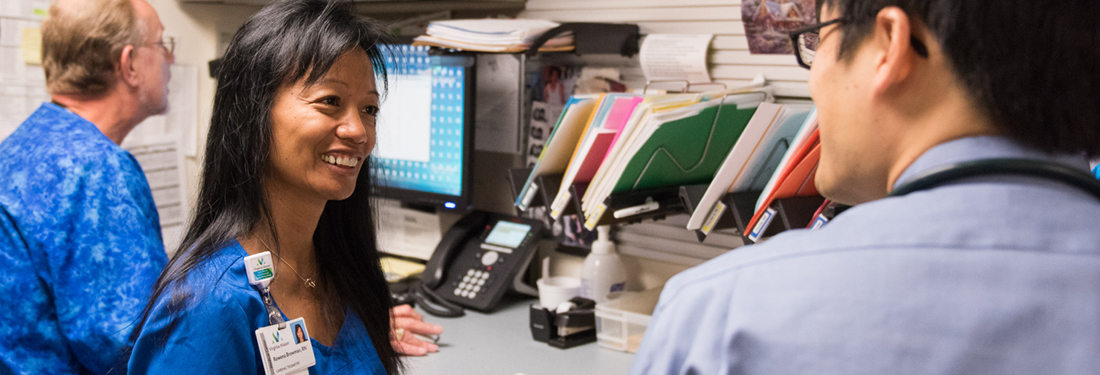Flow in Primary Care
Primary care physicians work on the frontlines of care delivery where they strive to serve a growing range of patients with increasingly complex needs, often filling in the care gaps for underserved populations. This work is complex, challenging, difficult, and often stressful. Furthermore, it is a job made more difficult by the demands of direct care documentation and indirect care — forms, referral management, formulary management —tasks beyond effectively communicating with patients about their health.
However, when these constraints are not a hindrance to the delivery of patient care, being a primary care physician is a job filled with the gratification that comes from longitudinal relationships with patients, and the rewards of gaining their trust as the result of providing excellent care.
Virginia Mason’s work in primary care has demonstrated that it is possible to eliminate the burden of work where it is wasteful and to improve the flow of care so that it truly maximizes the quality of time and attention each patient receives.
Kim Pittenger, MD, a family medicine practitioner at Virginia Mason Kirkland Medical Center, is experienced in implementing sustainable improvements within the primary care environment. Pittenger says, “Primary care physicians, too often, feel underappreciated and overworked, squeezed into systems where they spend ridiculous amounts of time on administrative junk,” adding, “And yet for their long hours and best efforts they are relatively underpaid, and often overworked, sometimes even at the expense of their own well-being — all because of inefficiencies in care, caused by bureaucracy, and ineffective, or outdated, patterns of work.” However, he suggests that there is another way.
Pittenger and his colleagues at Virginia Mason have optimized their work environment by improving flow. They have not only reduced the mountains of paperwork, email and phone messages, they once faced, but have also created a system that enables more doctors to go home on-time, with no unfinished charts or paperwork left behind.
How have they accomplished this? Working in flow balances the skill-task alignment across staff to reduce the overall time needed to perform each task, and as a result, helps to lower associated labor costs. In addition, wasteful activities that add no value, but are currently required, are identified and eliminated. This includes duplicate tasks, unnecessary processes, extra physical burdens, waiting, and overproduction.
By creating flow stations — and a flow production system — they have created a lasting method to eliminate waste from their work processes and maximize the efficiency of their time and efforts.
For example, a doctor completes a visit and walks into the hallway where the flow station is located. The medical assistant has three pieces of non-visit care ready — two emails to return and a form to sign. The doctor does not bolt to the next waiting patient until this indirect care is done. While the doctor works “in flow,” the medical assistant places the next patient in an exam room and addresses preliminary health screening elements.
The medical assistant — acting as a flow manager — is empowered to set up any necessary tests and vaccines within the Centers for Medicare & Medicaid Services rules and Virginia Mason protocols. Once complete, the medical assistant returns to the flow station and the doctor goes to the exam room to meet with the patient.
By removing the excess burden of work barrier, working in flow allows doctors to spend more quality time with patients, elevate medical assistants to a point where they flourish, and decrease phone volume (by 13,000 fewer calls a year per 10-provider group). Virginia Mason has shifted primary care from operating at a loss to becoming profitable. And thanks to flow, some primary care doctors are able to see more patients in the same amount of time.
Suggestions from Dr. Pittenger to physicians
Pittenger, who has been a driving force behind substantial transformational work in the primary care setting at Virginia Mason, encourages physicians to try a new approach:
Try this tomorrow morning. Reserve 10 minutes before your first patient to huddle with your medical assistant. Take a pile of lab results and divide them into reports you need to think about or research and those that can be reported as normal. Have your medical assistant put one abnormal lab (with paper chart if needed), one phone call and one paper form on your desk or otherwise emptied inbox in between every patient. Don’t run to the next patient until you have done these three pieces of work in one to two minutes. See how this feels.
Tell your medical assistant to hold the other piles of phone calls, labs and paper. The assistant is now in charge of dealing three “cards” per patient — and is now a flow manager. Explain that you are going to trial this and see how it feels and whether you have less of a pile to do at noon and after work.
You will likely have a much smaller batch at noon and after work. You will likely realize that it is time-consuming to go to your office in between every patient and that you could move this operation to a spot nearer the exam rooms, where the medical assistant works. If you use the timer on your smartphone, you will see that many of our indirect care tasks do take merely seconds.
You may run a few minutes behind on some visits, but if your medical assistant communicates this update to the patient, such as saying, “I expect the physician to be here in about three to four minutes,” the wait is not likely to impact the patient’s overall satisfaction.





